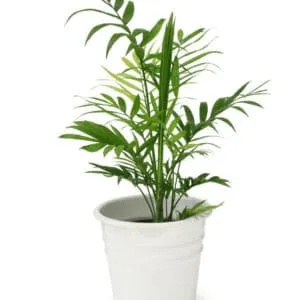Palm plants are usually considered to be towering trees that can be found in beach settings. You can, however, keep a smaller version indoors to add a tropical flair to your home.
There are over many to choose from, each of which is relatively easy to keep alive.
The majority of Palm plants can be found in the family Arecaceae, which are classified by perennial flowering plants.
As with many indoor plants, Palm plants grown inside the home have certain requirements as far as water, temperature, humidity, and many more.
This article will look at how to care for an indoor palm.
How to Care for an Indoor Palm
To care for an indoor palm provide it with well-draining soil using 50% peat moss and 50% percent perlite. Cactus soil mixes work as well. Keep the soil slightly humid when watering in spring and summer. Provide bright indirect light in an east-, west- or north-facing window. The ideal temperature for palm plants is 64-79°F (18-26°C). Keep humidity around 40% as a general rule of thumb. Use a slow-release fertilizer and fertilize 3 times a year with an NPK ratio of 12-4-12 or 8-2-12.

How to care for an indoor palm
Table of Contents
INDOOR PALM PLANT CARE
How to Care for an Indoor Palm.
The needs of a Palm plant differ depending on whether it is grown indoors or outdoors.
For the sake of this article, we will look at how to care for an indoor palm.
Species like the Ponytail Palm (Beaucarnea recurvata), the Areca Palm, Kentia Palm, Majesty Palm, or Bamboo Palm (Chamaedorea seifrizii).
SOIL
The best soil that you can choose for an indoor palm plant is one that can drain properly.
Typically, these generally include a mixture that is fifty percent peat moss and fifty percent perlite.
Some cactus or soil mixes are specifically designed for Palm plants.
When no other options are available, any commercial potting soil will do. Just be sure to pay close attention to how much water is added.
LIGHT
Palm plants won’t grow if they are placed in a room with no light.
On the other hand, direct sunlight can cause problems as well.
The best middle ground is to let your indoor palm plant be exposed to bright, indirect sunlight.
They prefer about six to eight hours of more intense light each day.

Areca Palm growing indoors
WATERING
One comforting note for those without a green thumb is that Palm plants are notorious for being tolerant to dry conditions.
Indoor palm plants however thrive best when the soil is kept evenly moist.
During the warmer months, you can let the soil slightly dry out so as to reset and avoid root rot.
I will discuss specific watering techniques later on.
TEMPERATURE
The ideal temperature for palm plants is 64-79°F (18-26°C).
Keep them above 60°F for active growth according to the University of Vermont.
As you would expect, Palm plants want to be placed in a warmer environment.
The colder months in autumn and winter is when the plant does not actively grow and are the only times that the temperature can drop below this range.
Watch carefully to make sure that it does not get below 54°F (12°C).
HUMIDITY
The humidity needs for Palm plants are quite variable.
Certain species such as the Thailand Lady Palm (Rhapis subtilis) need higher levels of humidity. Others, like the Parlor Palm (Chamaedorea elegans), are highly adaptive.
In general, it’s fair to assume that you should provide your indoor Palm plant with moderate humidity around 40%, increasing this moisture depending on how warm the room gets.
FERTILIZER
Fertilize indoor Palm plants up to 3 times a year using a slow-release fertilizer designed for palm plants.
The Clemson University recommends a fertilizer with an NPK ratio of 12-4-12 or 8-2-12 for indoor palms.
Never fertilize when the soil is dry.
Although not all Palm plants need fertilizer in order to survive, the general rule is that you should supply them with food. This is only necessary during the growing seasons or late winter to early fall.
There are a number of fertilizers specific to Palm plants.
Make sure the soil is evenly moist when fertilizing indoor palm plants.

A Ponytail Palm
PROPAGATION
Palm plants are known for their “pups”, offshoots that can be easily propagated into a new individual. There are a number of ways that you can propagate an Arecaceae.
These methods include separation, division, air layering, and seedling germination. You cannot propagate a Palm plant effectively through stem cuttings, as you can most flora.
Taking advantage of the palm pups is the easiest way to propagate your indoor plant.
GROWTH
On average, a palm tree plant will take about four to six years to grow to its full potential. There are some species of Palm plants that grow at a faster rate, so make sure to do your research on the specific type of Arecaceae that you own.
Indoor individuals typically reach a height of about six feet, whereas the classic palm tree you’d find outside can be a staggering twenty meters.
The following tips about potting keep your Palm plant from becoming a palm tree.
POTTING
With a slower growth rate, these plants do not need as much attention as some of your other flora. In fact, you’ll find it wise to repot them every three years or so.
Limiting the size of the pot will actually hold back the individual so that you don’t have a giant Palm plant on your hands.
With a more snug pot, the root mass can’t grow as large as it wants.
SUPPLYING YOUR PALM PLANT WITH PLENTY OF WATER
It was said earlier that Palm plants are tolerant to dry conditions. This is a true statement, but that doesn’t mean that you shouldn’t underwater your indoor flora. If you either give too much or too little, you’ll find the Palm plant struggling.
To get your watering schedule right, we’ve laid out the details on how much water they need and how best to provide that moisture.
PALM PLANT WATER NEEDS: WHEN, WHERE, AND HOW MUCH
The typical watering schedule for a Palm plant is multiple times a week. Of course, this depends on a number of variables.
If your indoor Palm plant is in a room that has more sunlight, you may want to lessen the amount of water within the week.
One good rule to go by is to take the size of the pot into consideration. Usually, the plant will need about as much water as it will take to fill the container.
If you’re unsure about your watering frequency, you can check the soil yourself. Using your finger, you can stick it down into the soil two inches. If the soil is dry past an inch, then you should add more.
Now let’s discuss how exactly you should go about watering. The best way to make sure that the whole Palm plant is saturated, add water until you see it dripping from the bottom of the container that it’s held in.
There should be plenty of drainage holes so that it isn’t left in standing water.

Indoor Palm Tree
USEFUL TIP FOR WATERING YOUR INDOOR PALM
When you water your plant, make sure to add it to the trunk base. Watering from overhead can be too much for the leaves. Watering around the base of the trunk also ensures that it is fully saturated.
Another note involves letting your plant dry out.
This should happen in the winter when the plant is not actively growing.
This is the only time of the year where your Palm plant would benefit from slightly drying out, so be careful to keep up a regular watering schedule.
PROPAGATING YOUR PALM PLANT THROUGH PUPS
When we say “pups”, we aren’t talking about cute, little puppies! Remember earlier in the article when we mentioned how this term refers to the offshoots? There are a number of methods that you could choose to use in obtaining a clone of your beloved Palm plant.
Taking notes from the experts, we’ve provided steps for the two most commonly used techniques involved in Palm plant propagation.
PROPAGATION THROUGH SEED GERMINATION STEPS
- Locate a reliable company that provides healthy Palm plant seeds, keeping in mind that fresh seeds will produce better individuals.
- Take the seed and place it into a small container with new soil, making sure that it is deep enough to be covered by a thin layer of topsoil. If placed too deep below the soil, the seed will not sprout.
- Place the container with seed in a warm room that gets lots of humidity, such as the bathroom. You can also wrap the potted individual in a plastic bag for added moisture.
- Check back every few weeks. Be aware that it can take a number of months depending on the species, on average around six.
- Once the seeds have begun to sprout, move the container to a room with even higher temperatures and humidity, even considering outside for the first summer.
- When the seedling becomes to start forming leaves, you can fertilize once a week and add a regular watering schedule.

A Bamboo Palm thriving in a pot
PROPAGATION THROUGH SEPARATION STEPS
- Choose the ideal Palm plant that you would like to copy, preferably one that is healthy with plenty of shoots.
- Carefully take the Palm plant and remove it from the pot, looking for a side shoot that is at least a foot in length. The best shoots will have an abundance of roots.
- With clean, sharp scissors, cut the sucker from the original plant close to the base of the parent Palm plant if possible.
- Put the freshly cut individual into a small pot after the soil has been saturated and continue by covering the sucker with a plastic bag.
- Check back on your new plant once a week, adding water if the soil dries out.
- Remove the plastic bag from the pot after a month and continue to look for roots, slowing down your watering schedule once the plant has matured.
PALM PRUNING: FROM TREE TO PLANT
Palm plants aren’t your usual indoor flora additions. Unlike other plants, you must know a few things before attempting to prune. It may be tempting to simply hack away at the leaves that grow a bit too long, but we urge you to read these pruning protips first.
Members of Arecaceae are monocots, meaning that they grow a single leaf at a given time. This is why we suggest that you consider the do’s and don’ts behind Palm plant pruning.
To keep it simple, we’ve compiled a readily available list that you can reference when your Palm plant starts looking like a tree.
Season-specific: Choosing to prune in the warmer months, such as spring and summer will yield much better results and keep the plant healthy.
Dead Foliage: Typically, you’d remove or prune back any leaves that seem to lose their appeal. If you can do so easily, go ahead. If not, leave them. You’ll damage the plant if you remove too much, even the dying leaves.
Maturity: As hard as it may be, leave your growing Palm plant alone until it at least has a few years to mature. If you really don’t like that idea, simply don’t touch two fronds to allow for better growth.
Trunk Woes: Be extremely careful not to knick the trunk when you’re trimming back the leaves as this section of the plant is essential in absorbing important nutrients.
Flowers and Fruits: This may sound contradictory, but you actually want to remove any new flowers and fruit stalks as they take a crazy amount of energy from the plant. Those that you don’t remove will naturally fall anyhow.
TOP TIP-OFFS TO AN UNHEALTHY PALM PLANT
Knowing the potential problems that may arise in your Palm plant can keep you on your toes. Here are a few of the most common issues that Arecaceae owners face and how to solve them firsthand before it gets worse.
TELLTALE SIGN #1: LEAF TIPS TURNING BROWN
Cause: A number of reasons can cause the tips of the leaves to shift to brown including overexposure to heat or underwatering.
Remedy: Luckily, this problem is fixed rather quickly when dealt with immediately. Begin by moving your Palm plant to a room with slightly cooler temperatures. If that doesn’t work, increase the water that you add on a weekly basis.
TELLTALE SIGN #2: FRONDS HELD TOGETHER TIGHTLY
Cause: If the leaves don’t spread out naturally, then there is likely an insufficiency in Zinc. This is commonly referred to as “ladder leaf”.
Remedy: Adding fertilizer around the base of the Palm plant can solve Ladder leaf. Just be sure that it includes some levels of Zinc.
PROVIDING YOUR PALM PLANT WITH THE BEST CARE IN 5 STEPS
Sure, there’s a lot when it comes to caring for a small Palm plant. If you feel overwhelmed, use these five takeaways to care for your new fronds.
- Keep the soil evenly saturated, watering a few times a week unless the plant seems to be struggling.
- Provide your Palm plant with a room that has plenty of bright, partial sunlight.
- Refer to our list of do’s and don’ts before pruning!
- Repot these plants every few years, making sure that the pot isn’t too large or else you’ll have a gigantic indoor dweller.
- Pay attention to the signs of an unhappy plant such as brown tips or the fronds being held tightly together and make the necessary changes.
Frequently Asked Questions About How to Care for an Indoor Palm
Is a Palm plant an indoor plant?
With the correct care and attention, these plants are considered to be a fun, tropical addition. They only require a smaller pot in order to retain their petite form.
Do indoor Palms need misting?
Being on the less picky side, Palm plants do not need misting, however, they wouldn’t mind a good spritz on a regular basis in addition to their regular watering routine.
Should I cut off brown Palm leaves?
If you notice any green on the leaf, leave it alone. Once it has fully shifted to a brown color, you can fully remove that frond.

Daniel has been a plant enthusiast for over 20 years. He owns hundreds of houseplants and prepares for the chili growing seasons yearly with great anticipation. His favorite plants are plant species in the Araceae family, such as Monstera, Philodendron, and Anthurium. He also loves gardening and is growing hot peppers, tomatoes, and many more vegetables.


